The Sweetgum Guide
Sweetgum (Liquidambar styraciflua) is a stately, deciduous shade tree valued for its star-shaped leaves, symmetrical form, and dramatic fall color. A native of the southeastern United States, it adapts well to a variety of climates and soils, offering seasonal beauty and structural impact in parks, large lawns, and street plantings. Though known for its spiky seed pods, sweetgum remains a popular choice where space permits and fall brilliance is desired.
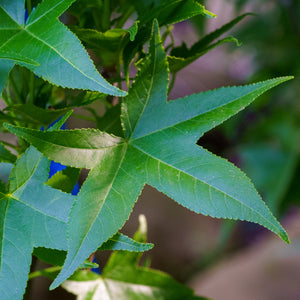
About
Liquidambar styraciflua is a large, pyramidal tree that typically grows 50 to 75 feet tall, with some specimens reaching over 100 feet in ideal conditions. Its defining features include:
- Star-shaped, glossy green leaves with five to seven lobes that resemble maple leaves.
- Outstanding fall color, ranging from yellow and orange to deep red and purple—often all on the same tree.
- Woody, spiked fruiting balls, known as gumballs, that persist into winter.
Sweetgum is a true hardwood, historically used in furniture making, veneers, and flooring. Its strong, symmetrical shape and upright branching habit make it a popular shade tree when properly sited.
Improved cultivars have expanded its versatility:
- 'Rotundiloba': Nearly fruitless variety with rounded lobes and excellent fall color.
- 'Slender Silhouette': Columnar form for narrow spaces, reaching 40–50 feet tall but only 5–6 feet wide.
- 'Cherokee': Compact growth with rich red and orange fall foliage.
- 'Happidaze': Seedless selection with upright branching and a clean habit.
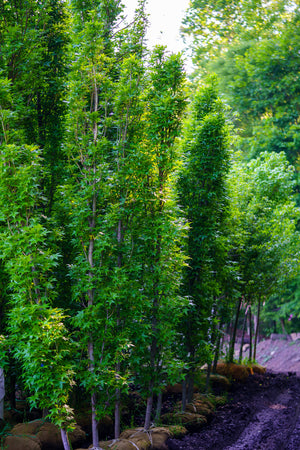
PLANTING
USDA Hardiness Zones: Hardy in Zones 5–9, depending on cultivar and microclimate.
Soil: Prefers deep, moist, acidic soil but adapts to clay and sandy conditions. Avoid shallow or excessively alkaline soils.
Sunlight: Full sun is essential for best growth and fall coloration.
Watering: Requires regular watering during establishment. Once established, it is moderately drought tolerant but prefers consistent moisture.
Spacing: Allow 30–50 feet between trees. Slender forms may be planted closer for vertical accents.
Planting Time: Plant in spring or fall when the soil is workable and temperatures are mild.
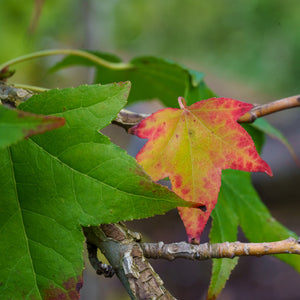
CARE
Watering: Deep water weekly during dry periods, especially in the first three years. Mulching helps retain moisture.
Fertilizing: Apply a balanced fertilizer in early spring if growth is slow or leaves show signs of nutrient deficiency.
Pruning: Minimal pruning required. Remove dead, damaged, or crossing branches in late winter. Shape young trees early to promote strong branching.
Pests and Diseases: Generally resistant to serious issues, but may occasionally experience leaf spot, canker, or scale. Monitor for early symptoms and treat as needed.
Mulching: Mulch annually with 2–3 inches of organic material to protect the roots and suppress weeds. Keep mulch away from the trunk.
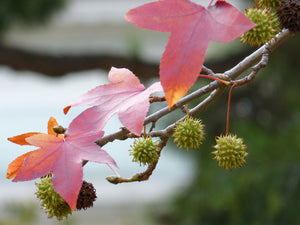
HOW TO USE
Shade Tree for Large Lawns: Sweetgum’s broad canopy offers dense shade, making it ideal for open yards, estate plantings, and public greenspaces.
Fall Color Feature: Plant as a focal point in the landscape or in groupings along streets and walkways where autumn foliage can be fully appreciated.
Vertical Accent: Columnar cultivars like 'Slender Silhouette' are perfect for tight spaces or narrow corridors, offering height without excessive spread.
Wildlife Habitat: The gumballs feed birds and small mammals during winter. Their persistence on the tree adds visual texture to the dormant season.
Naturalized Areas and Parks: Sweetgum’s adaptability and tolerance for seasonal flooding make it suitable for large-scale plantings, buffer zones, and reforestation projects.
Urban Settings: With proper root space and improved cultivars, sweetgum can perform well in urban landscapes. Use in medians or along sidewalks with seedless forms to minimize cleanup.
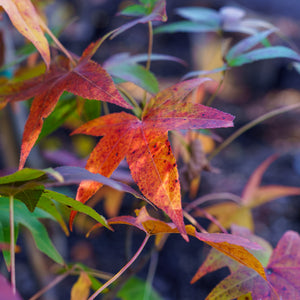
Common Questions
Is sweetgum a hardwood? Yes, sweetgum is a true hardwood with a dense grain, used in furniture, cabinetry, and veneers.
What is sweetgum good for? It is valued for shade, fall color, wildlife support, and as a durable timber species. It also serves as an attractive, long-lived specimen in the landscape.
How big does a sweetgum tree get? Typically grows 50–75 feet tall with a 30–50 foot spread. Some cultivars are more compact or narrow in form.
How fast do sweetgum trees grow? Moderate growth rate—about 1 to 2 feet per year depending on site conditions.
How to identify a sweetgum tree? Look for star-shaped, glossy leaves, corky ridges on young branches, and spiky seed balls hanging in clusters. Fall foliage is multi-colored and vibrant.
Do sweetgum trees need full sun? Yes, full sun is required for strong growth and optimal leaf color.
What are the balls on a sweetgum tree? These are the seed pods or fruit—woody, spherical structures covered in short spines. They persist through winter and can be messy in high-traffic areas.
Conclusion
Sweetgum is a classic American shade tree that blends beauty, resilience, and utility. With starry leaves that light up in fall, a strong architectural presence, and cultivars that reduce or eliminate messy fruit, it brings long-term value to the landscape. Whether you’re planting for autumn color, urban design, or reforestation, sweetgum offers both charm and substance in every season.
The Sweetgum Collection
Sold Out
